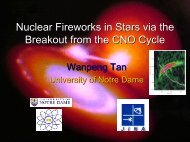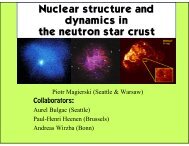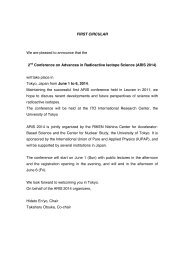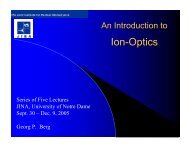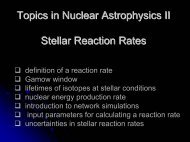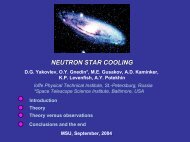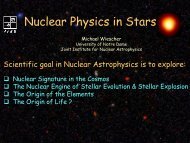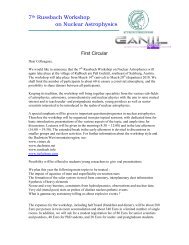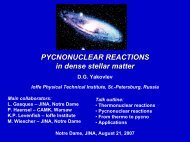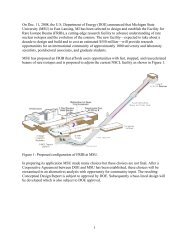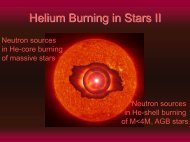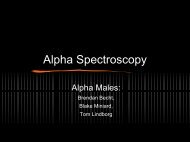OPPORTUNITIES IN NUCLEAR SCIENCE A Long-Range Plan for ...
OPPORTUNITIES IN NUCLEAR SCIENCE A Long-Range Plan for ...
OPPORTUNITIES IN NUCLEAR SCIENCE A Long-Range Plan for ...
Create successful ePaper yourself
Turn your PDF publications into a flip-book with our unique Google optimized e-Paper software.
THE <strong>SCIENCE</strong> • PROTONS AND NEUTRONS: STRUCTURE AND <strong>IN</strong>TERACTIONS<br />
ized data from CEBAF, shown in Figure 2.10, appear to be<br />
consistent with expectations from either the quark-gluon or<br />
the meson-nucleon view. To understand the range of applicability<br />
of the two pictures, it is essential to extend these and<br />
related measurements in deuterium and other light nuclei to<br />
the highest possible values of momentum transfer, where<br />
sensitivity to the quarks alone would be enhanced. Such a<br />
program can be carried out by upgrading the CEBAF accelerator<br />
to 12 GeV.<br />
Another avenue <strong>for</strong> investigating the role of quarks in<br />
nuclei is by using high-energy gamma rays to break up<br />
the deuteron into a proton and a neutron. In general, the<br />
momentum transferred to the two nucleons can be substantially<br />
higher than in the case of electron scattering. It appears<br />
that high-energy two-nucleon breakup of deuterium is, in<br />
fact, consistent with the quark-gluon picture, whereas available<br />
meson-nucleon models fail to explain the data. Recent<br />
polarization data show very similar behavior, which would<br />
be completely unexpected in a meson-nucleon picture.<br />
Even the best available model of the NN <strong>for</strong>ce cannot<br />
accurately explain nuclear binding. To reproduce the binding<br />
energies of the simplest light nuclei, it is necessary to add<br />
three-body <strong>for</strong>ces to the pairwise interactions determined<br />
from nucleon-nucleon scattering (see “Theoretical Advances,”<br />
pages 30–31). Unless such <strong>for</strong>ces are considered, the binding<br />
energies of light nuclei are too small, and the binding of<br />
nuclear matter, relevant <strong>for</strong> understanding neutron stars, is<br />
too large. Precise new polarization data from the Indiana<br />
University Cyclotron Facility (IUCF) constrain the calculations<br />
of the spin-dependent part of the three-body <strong>for</strong>ce.<br />
Theoretical Advances<br />
In recent years, theoretical investigations of the internal<br />
structure of the nucleon, and hadrons in general, have<br />
focused mainly on achieving close ties to the fundamental<br />
theory of strong interactions, QCD. At present, three<br />
approaches are promising. The first is numerical simulation<br />
of lattice field theory, the only way known to directly solve<br />
“strong” QCD with controlled errors. A second approach<br />
focuses on low energies and exploits the spontaneous breaking<br />
of chiral symmetry that is an important consequence of<br />
strong QCD. This is the effective field theory approach (see<br />
above) that has been used with great success in establishing<br />
the Standard Model of electroweak and strong interactions.<br />
f d A<br />
10 – 4 JLab Hall A<br />
SLAC E101<br />
10 – 5<br />
10 – 6<br />
10 – 7<br />
10 – 8<br />
10 – 9<br />
0.04<br />
0.03<br />
0.02<br />
0.01<br />
Reduced deuteron <strong>for</strong>m factor<br />
f d (Q 2 ) = F d (Q 2 )/F N<br />
2 (Q<br />
2 /4)<br />
0.00<br />
0.5 2 4 6<br />
Q 2 [(GeV/c) 2 ]<br />
pQCD<br />
Figure 2.10. Electron-deuteron scattering results. Measurements<br />
of unpolarized electron-deuteron scattering cross sections from<br />
SLAC and Jefferson Lab, characterized by the structure function<br />
A(Q 2 ), are consistent with meson-nucleon–based theories of<br />
nuclei (upper figure), while at higher Q 2 , they also become consistent<br />
with the behavior predicted by quark-gluon–based theories<br />
(lower figure).<br />
The third approach is perturbative QCD, a powerful tool to<br />
extract the structure of the nucleon from high-energy scattering<br />
processes.<br />
Lattice QCD. Although the idea of lattice regularization<br />
was introduced shortly after the advent of QCD, only<br />
recently have the algorithmic, analytical, and computational<br />
tools been developed to the point that lattice QCD calculations<br />
can have a major impact. In particular, practical methods<br />
have been found <strong>for</strong> incorporating an exact <strong>for</strong>m of<br />
chiral symmetry on a lattice, and all the tools are now at<br />
25



